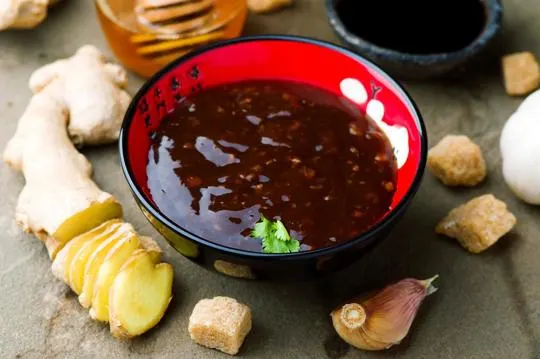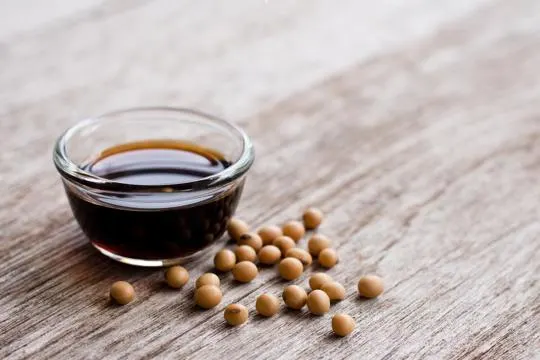Summary of key points
The main difference between teriyaki and soy sauce is in the ingredients used. Soy sauce is made from fermented soybeans, wheat, water, and salt. Teriyaki sauce is typically made with soy sauce as a base, but it also includes other ingredients such as sugar, mirin (a type of sweet rice wine), and sake.
In terms of flavor, soy sauce has a salty and savory taste, while teriyaki sauce has a sweeter and tangier flavor. This makes soy sauce better suited for savory dishes, while teriyaki is often used as a glaze or marinade for meats.
In addition to the main differences, it’s also worth noting that soy sauce is a thinner liquid, while teriyaki sauce is thicker and has a tendency to caramelize when cooked.
Ever stood in the sauce aisle, teriyaki in one hand, soy sauce in the other, and thought, “Aren’t these the same thing?” You’re not alone. These staples in our kitchens do more than just season our stir-fries.
Teriyaki is like soy sauce’s sweeter, thicker cousin; it’s got sugar, garlic, and ginger playing in its band. Soy sauce, on the other hand, is the solo act – pure, salty, and straightforward.
Our story with these sauces started with a botched dinner attempt. Soy sauce flooded what was supposed to be a teriyaki dish. It was a salty disaster.
Now, we’re here to dissect these sauces for you.
What is Teriyaki Sauce?

Teriyaki sauce is a traditional Japanese sauce made from soy sauce, sugar, and rice wine vinegar.
It has a unique flavor profile that is both sweet and salty, with a hint of tanginess.
The sauce can be used as a marinade for various meats, such as chicken, beef, or fish, and can also be used as a stir-fry sauce or dipping sauce for vegetables or dumplings.
One unique aspect of teriyaki sauce is that it is cooked down to a thick, syrupy consistency, which makes it perfect for glazing meats or vegetables.
While the exact origin of teriyaki sauce is unclear, its popularity has spread worldwide due to the delicious and versatile flavor it brings to any dish.
What is Soy Sauce?

Soy sauce, the dark-colored liquid, is a staple ingredient in many kitchens worldwide, but do you know what it actually is? Well, sit back and prepare to unravel this mystery of the orient.
Soy sauce is a savory condiment that is derived from soybeans, wheat, salt, and koji, a mold that converts the mixture into amino acids, organic acids, and other compounds.
The process of making soy sauce is intricate and often involves a lengthy fermentation period, which can range from several months to years.
The result is a complex and flavorful umami taste that is perfect for adding depth to stir-fries, marinades, dipping sauces, and more.
With its rich history and versatility, it’s no wonder why soy sauce has become a household name for its unique and unparalleled flavor.
Differences Between Teriyaki Sauce and Soy Sauce

Teriyaki and soy sauces are unlike in flavor, ingredients, and usage.
Ingredients Used
Teriyaki and soy sauce are both Asian favorites.
But what sets them apart? Ingredient-wise.
Teriyaki usually combines soy sauce with other seasonings.
Mirin, sake, and sugar create a sweet and savory flavor.
Soy sauce? It’s made with only fermented soybeans and wheat.
This gives it a salty and tangy taste.
Both sauces provide umami-rich flavors.
But their ingredients make them distinct.
Knowing the difference helps you pick the perfect sauce for your next Asian meal.
Flavor and Taste
Teriyaki and soy sauce may appear similar, but they have different flavors.
Teriyaki has a sweet, tangy taste, with a hint of umami from mirin and sake.
On the other hand, soy sauce has a savory, salty flavor, coming from fermented soybeans.
Both sauces can enhance dishes in their own ways.
The sweetness of teriyaki comes from sugar or honey mixed with soy sauce.
This blend creates a caramelized glaze when cooked, giving more flavor to meats and vegetables.
The tanginess comes from added vinegar or citrus juices, which balance out the sweetness.
Mirin and sake also add complexity.
In comparison, soy sauce is known for its rich umami flavor.
It is made with fermented soybeans and wheat or barley, providing flavor to different foods.
Soy sauce usually has a higher salt content than teriyaki sauce, giving it a saltier taste.
It is often used for dipping and seasoning stir-fries, marinades, and sushi.
Although they both contribute to dishes’ taste, the choice between teriyaki and soy sauce depends on personal preference and desired flavors.
Teriyaki adds sweetness and tanginess to grilled chicken or salmon, while soy sauce gives an intense umami punch to stir-fried noodles or vegetable dishes.
So, although teriyaki and soy sauce have similarities, they have their own unique flavors that can improve different foods.
The decision between the two depends on your taste.
Trying both can open up a whole new culinary experience.
Usage and Application
Teriyaki and soy sauce are both popular in Asian cuisine but with distinct differences in usage and application.
Teriyaki is mainly used as a marinade for meat, fish, or veggies before grilling/broiling.
It adds sweetness and a savory glaze.
Soy sauce is a versatile seasoning agent for recipes or a table condiment.
It brings umami flavor and a savory kick.
Usability-wise, teriyaki is best as an ingredient or basting sauce.
The sugars caramelize with heat, creating a glossy glaze.
Soy sauce can be added during any cooking stage.
It’s great for marinades due to its flavor and ability to tenderize protein.
Application: Teriyaki is usually brushed onto food or used as a glaze after cooking.
Soy sauce is added directly through measuring spoons or poured into stir-fries.
In summary: Teriyaki adds sweet and savory flavors to grilled/broiled dishes.
Soy sauce is a seasoning and condiment that delivers umami flavor and saltiness.
Cooking Methods
Cooking methods are key to the flavor and texture of a dish.
Each has its own effects, so it’s important to understand the differences.
From grilling to baking, sautéing, steaming and even boiling – every technique adds something special.
Grilling adds smoky flavors and a caramelized exterior.
It involves cooking food over an open flame or hot coals.
Baking is dry heat in an oven, allowing for even cooking and browning.
Sautéing is popular with chefs, as it’s fast and uses minimal oil.
It keeps the flavors and nutrients intact.
Whereas, steaming preserves colors and flavors by heating with steam, keeping food moist.
Boiling submerges ingredients in liquid at high temperature, making pasta or veggies tender.
Knowing about the methods helps you make recipe choices.
Each one brings something unique – like intense flavors from grilling or delicate textures from steaming.
Experimenting helps you take your cooking to the next level and thrill your taste buds each time you’re in the kitchen.
Similarities Between Teriyaki Sauce and Soy Sauce

Teriyaki & soy sauces are both well-known in Asian cuisine.
They both give a savory umami flavor.
They are both made from fermented soybeans.
However, teriyaki has other ingredients like mirin, sake & sugar.
Teriyaki is sweeter, unlike soy sauce which is saltier.
Both sauces can bring out the taste of various dishes, although they have distinct characteristics.
Popular Dishes and Cuisines That Use Teriyaki Sauce and Soy Sauce
Teriyaki sauce and soy sauce are two flavoursome staples used in many popular dishes.
Teriyaki chicken is a classic example that uses this savory sauce.
Additionally, teriyaki beef is another well-known dish.
In Japanese cuisine, soy sauce adds a salty yet umami taste to dishes like sushi and sashimi.
Chinese cuisine also relies on soy sauce for many stir-fries and marinades.
Korean barbecue often incorporates a soy-based marinade for its meat selections.
Thai cuisine also employs soy sauce to balance out other ingredients in dishes like pad thai or fried rice.
Indonesian cuisine embraces kecap manis – a syrupy soy sauce – adding a sweet yet savory element.
Fusion recipes are emerging that combine elements from different cultures.
Examples include teriyaki burgers or soy-glazed salmon with tropical salsa.
These dishes showcase the adaptability of both sauces to integrate diverse flavors.
In conclusion, teriyaki sauce and soy sauce are integral in numerous dishes across the world.
Their ability to add sweet and savory profiles make them essential ingredients.
Choosing Between Teriyaki Sauce and Soy Sauce: Which to Use When?
Choosing between teriyaki sauce and soy sauce can be tricky.
Both sauces have unique flavors and qualities that can enhance dishes.
To make a good decision, it’s important to know the difference between them.
Teriyaki sauce is a Japanese sauce that gives a sweet and savory flavor.
It’s made from soy sauce, mirin, sugar, and seasonings.
The sweetness comes from the sugars in the sauce.
It’s often used as a marinade or glaze for grilled or broiled meats.
Soy sauce is a condiment in many Asian cuisines, like Chinese and Japanese.
It’s made from fermented soybeans, wheat, salt, and water.
Soy sauce has a rich umami flavor that adds depth to dishes.
It’s great for seasoning stir-fries, dipping sauces, soups, and marinades.
The difference between the two sauces is in their preparation methods and additional ingredients.
Teriyaki sauce is sweeter than soy sauce.
When cooking, consider the taste you want.
Teriyaki sauce is good for a subtly sweet flavor profile.
It works well with grilled or roasted meats.
Soy sauce is better for bolder flavors with a salty kick.
Conclusion
In conclusion, both Teriyaki and Soy Sauce are delicious Asian-style sauces that can turn a bland meal into a delectable masterpiece.
Although they do have differing tastes, both sauces provide a unique taste and flavor of their own.
Soy Sauce has a salty yet simple flavor, while Teriyaki boasts a sweet and savory combination.
While one may prefer the traditional taste of Soy Sauce or the sweetness that Teriyaki provides, it is important to emphasize that there really is no right or wrong answer when choosing between these two delicious options.
Therefore, whether you’d like to dip your sushi rolls in some straight Soy Sauce or prefer to slather some Teriyaki atop your dryer dishes like fried noodles, you can rest easy knowing either sauce will provide an explosion of flavor.
Whichever Asian-style sauce you choose for your next dish, we wish you the best of luck as we know you won’t be disappointed with the flavors delivered.

Leave a comment